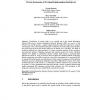JUCS
2011
13 years 6 months ago
2011
: Visualization of search results is an essential step in the textual Information Retrieval (IR) process. Indeed, Information Retrieval Interfaces (IRIs) are used as a link between...
ECIR
2011
Springer
13 years 7 months ago
2011
Springer
In large web search engines the performance of Information Retrieval systems is a key issue. Block-based compression methods are often used to improve the search performance, but c...
ACL
2011
13 years 7 months ago
2011
Marking up search queries with linguistic annotations such as part-of-speech tags, capitalization, and segmentation, is an important part of query processing and understanding in ...
ACHI
2010
IEEE
13 years 7 months ago
2010
IEEE
Abstract—One of the first Multi-Language Information Retrieval (MLIR) systems was implemented in 1969 by Gerard Salton who enhanced his SMART system to retrieve multilingual doc...
SIGIR
2010
ACM
13 years 10 months ago
2010
ACM
The size of the Web as well as user bases of search systems continue to grow exponentially. Consequently, providing subsecond query response times and high query throughput become...
CORR
2011
Springer
13 years 10 months ago
2011
Springer
Information Retrieval systems can be improved by exploiting context information such as user and document features. This article presents a model based on overlapping probabilistic...
IPM
2010
14 years 21 days ago
2010
Focusing on the context of XML retrieval, in this paper we propose a general methodology for managing structured queries (involving both content and structure) within any given st...
CICLING
2009
Springer
14 years 1 months ago
2009
Springer
Abstract. Previous work has shown that modeling relationships between articles of a regulation as vertices of a graph network works twice as better than traditional information ret...
TPDS
2002
14 years 3 months ago
2002
The problem of question/answering (Q/A) is to find answers to open-domain questions by searching large collections of documents. Unlike information retrieval systems, very common ...
IWC
1998
14 years 3 months ago
1998
The aim of an information retrieval system is to nd relevant documents, thus relevance is a (if not `the') central concept of information retrieval. Notwithstanding its impor...




